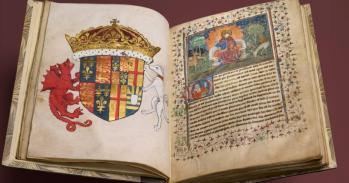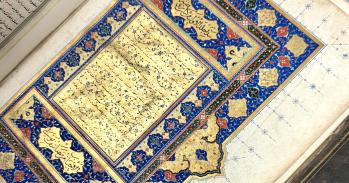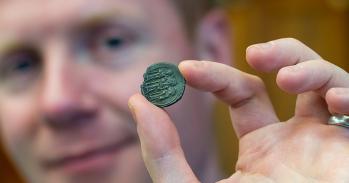
Scholars from five different institutions, and both Christian and Muslim backgrounds, will gather in Cambridge tomorrow to look at medieval Islamic marriage and how it was viewed by contemporary Christian travellers and polemicists.
Scholars from five different institutions, and both Christian and Muslim backgrounds, will gather in Cambridge tomorrow to look at medieval Islamic marriage and how it was viewed by contemporary Christian travellers and polemicists.
Although medieval authors often tend to exaggerate them, the differences in the doctrines and practices of marriage, an institution fundamental to the ways in which societies operate, do indeed represent one of the main disjunctures between medieval Islam and medieval Christianity.
In the late 15th century Anselm Adorno, an official of the Dukes of Burgundy, and his son John set out from the Belgian city of Bruges to the Holy Land. The purpose of their journey was to visit the places of Christ’s death and resurrection. Unlike many other pilgrims, who took the sea route from Venice to Jaffa, Anselm and John decided to travel through the predominantly Muslim countries of Tunisia and Egypt. It was here that they encountered for the first time in their lives Islamic culture, including local Islamic marriage customs. They recounted their observations with great detail in their travel account, written after their return.
An extract from this travelogue, translated from the original Latin, reads: “They get married in the following way: The man addresses the parents of the girl he wants to marry: If they agree with the marriage, the parents of both parties gather in the house of the girl, in order to rejoice and celebrate their children’s engagement. After the banquet the bride to be goes into a room, where she stands all naked, covering only her intimate parts. Her fiancé goes into the adjacent room, where he stands all naked too. There they look at each other through a little hole to see if they like each other. If they like each other, they immediately call for an official, called scyher, to write down the marriage agreement, called sedath.
“Once the agreement has been written down, they establish the wedding day (dies nupcialis). On that day in the morning, the bride and the groom enter at dawn a room where a bed is prepared for them. The mothers and the other women sit at the door and listen to all the words and motions of the groom and the bride. As soon as they realise that they have consummated their marriage, they immediately start shouting in a loud voice: 'Rejoice, rejoice, the marriage is consummated'. When the bride and the groom hear these voices, they dress up and leave the room for the wedding feast.”
This rare report of medieval Islamic wedding customs, as described by two European Christian travellers, will be just one of many discussion points at a workshop taking place this Friday at the University of Cambridge Centre for Research in the Arts, Social Sciences and Humanities (CRASSH). The event brings together scholars from five institutions, including, besides several speakers from Cambridge itself, Alexander Schilling from Jena University, Charles Burnett from the Warburg Institute, Yossef Rapoport from Queen Mary, University of London and Khaled Younes from the University of Leiden.
The workshop has been organised by Dr Pavel Blazek, a medievalist at the Institute of Philosophy, Czech Academy of Sciences, and currently Eurias Fellow at CRASSH and Clare Hall. “The aim of the workshop will be to look at medieval Western perceptions of Islamic marriage and to compare them with the social and legal realities of marriage in medieval Islamic societies as well as with the writings on the subject by medieval Muslim scholars and in Islamic literature,” he said.
“My own research explores medieval western views of Islamic marriage by drawing on two types of historical sources. On the one hand, I look at medieval travelogues, written by Western Christian travellers to Islamic countries. They give us glimpses – often tantalisingly slight and vague – of the different marriage practices in Islamic countries they encounter and how they perceive them. Apart from the travelogues by Anselm and John Adorno, they include the fascinating accounts of Simone Sigoli, Gucci and Frescobaldi, three Florentines who visited Egypt in 1348, and the travelogue of Anselm of Harff, a knight from the lower Rhine region who in the years 1496-98 undertook, via Egypt, a kind of “super-pilgrimage” to the main Christian pilgrimage centres: the Holy Land, Rome and Santiago of Compostella.
“On the other hand, I compare these sources with what authors of medieval anti-Islamic treatises, such as Peter Alphonsi, Alain of Lille and Riccoldo of Montecroce, have to say on the subject of Islamic marriage. While travelogues are more concerned with the practice of marriage in medieval Islamic countries and often report it, like Anselm and John Adorno, in a fairly neutral and unbiased way, authors of anti-Islamic treatises focus exclusively on the doctrine of marriage in the Qur’an and in Islam. They do so in a highly polemical tone and always with the underlying intention of refuting what they see as the ‘errors of the Mohametan religion’.”
Although medieval authors often tend to exaggerate them, the differences in the doctrines and practices of marriage, an institution fundamental to the ways in which societies operate, do indeed represent one of the main disjunctures between medieval Islam and medieval Christianity. Whereas medieval Christianity, following the teaching of the New Testament and Church Fathers, recognised only monogamous marriage and taught that it could not be dissolved, medieval Islam, following the Qur’an, permitted divorce as well as polygamy and concubinage with female slaves.
This basic doctrinal difference exercised a profound influence on the social and legal practice of marriage in medieval Christian and Islamic societies. In the Dar al-Islam divorce and remarriage were widespread and both multiple marriages and concubinage were legal (albeit much less frequent), while in medieval Christendom monogamous marriage till death do us part became the legal and social norm by the Central Middle Ages (with extra-marital relations and divorce – in the form of Church annulments – continuing to exist, but rather as deviations from and confirmations of this norm).
Medieval sources, and medieval anti-Islamic treatises in particular, point not only to the real differences between doctrines, but also testify to the over-riding negativity of the Medieval West towards a religion which did not share the same teachings and moral values. “Islamic polygamy, concubinage and divorce were usually interpreted by western medieval authors as proof of the 'irrationality' of Islam and as expressions of ‘Mahometan licentiousness’. What is apparent is vehement disapproval and little attempt to understand,” said Dr Blazek.
What can a workshop like this contribute to current debates and conflicts between Christianity and the West on one hand and the world of Islam on the other? Dr Blazek argues that, although the meeting does not set out explicitly to shine a light on the religious and cultural tensions felt today between Christians and Muslims, it is nevertheless instructive to look at the past to understand the present.
“Since the Middle Ages much, of course, has changed. Mainly as a result of secularisation, divorce has also become commonplace in the West, while, with a few exceptions, polygamy is for the most part no longer seen as acceptable by Muslims and its practice is dying out. The Islamic practice of taking slaves as concubines appears to have died out completely in the course of the 18th and 19th centuries, along with the extinction of slavery in Islamic countries. “However, with the emergence of western individualism, liberalism and feminism, as well as an overall process of democratisation of western societies, we have seen the emergence of new differences between the Western and Islamic concept of marriage,” he said.
“These differences include such intensively debated issues as the position and the role of women and men in and outside marriage in Islamic societies and the extent of freedom to choose one’s own marriage partner. While some of these differences between the Western and Islamic idea marriage already existed in the Middle Ages, they were less pronounced than today and, perhaps because of that, less frequently noticed and commented on by medieval travellers and writers. The workshop certainly can’t provide ready-made answers to these questions, but it can make us think about them in a longer historical perspective.”
This work is licensed under a Creative Commons Licence. If you use this content on your site please link back to this page.





